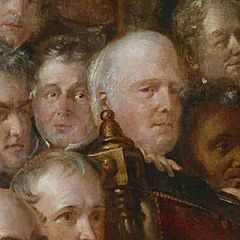Jonathan Backhouse (1779–1842) facts for kids
Quick facts for kids
Jonathan Backhouse
|
|
|---|---|

left to right:Stephen Lushington, Sir John Eardley-Wilmot, Jonathan Backhouse with L.C. Lecesne and others in 1840.
|
|
| Born | 19 January 1779 |
| Died | 7 October 1842 |
| Nationality | English |
| Occupation | Banker |
| Known for | Bankers to the Stockton and Darlington Railway |
| Spouse(s) | Hannah Chapman |
Jonathan Backhouse (born January 19, 1779 – died October 7, 1842) was a very important banker from a town called Darlington in England. He is famous for helping to pay for the first public railway in the world, the Stockton and Darlington Railway. He was married to Hannah Chapman Backhouse, who was a Quaker preacher.
Contents
Early Life and Family
Jonathan Backhouse came from a family of bankers in Darlington. His father, also named Jonathan Backhouse, was a banker too. His mother, Ann, was the daughter of Edward Pease, another important person from Darlington.
When his father passed away, Jonathan took over the family business. This bank later became known as Backhouse's Bank. In 1811, he married Hannah Chapman Gurney. Hannah was connected to several other important Quaker families.
Financing the First Public Railway
Jonathan Backhouse played a huge role in making the Stockton and Darlington Railway happen. This railway was a big deal because it was one of the first public railways in the world. It helped transport coal from mines to the coast.
Raising Money for the Railway
Jonathan helped raise a lot of money for the railway, about £125,000. That was a massive amount back then! He put in £20,000 of his own money. Even more, he got £80,000 from his friends and contacts who were also Quaker bankers.
A Story of Gold and a Missing Wheel
There's an interesting story about Jonathan Backhouse and the railway. The Earl of Darlington was upset because the new railway was causing problems for his fox hunting. He tried to make Backhouse's bank run out of money.
When Jonathan found out about this plan, he quickly went to London. He needed to get a lot of gold to protect his bank. On his way back to Darlington, racing against time, one of the wheels on his carriage broke off! But Jonathan was clever. He moved the heavy gold around in the carriage so that it stayed balanced. He managed to finish his journey with only three wheels, saving his bank!
Quaker Ministry and Anti-Slavery Work
In 1833, Jonathan Backhouse decided to stop working as a banker. He wanted to spend more time on his Quaker ministry. Quakers are a religious group known for their peaceful beliefs and work for social justice.
Travels and Preaching
Jonathan traveled to America with his wife, Hannah. Hannah was a well-known preacher and toured many places, giving sermons. Jonathan had to return to the UK twice during their travels.
Hannah traveled with another Quaker, Eliza MacBride, preaching in the southern states of America. She was very upset to see slave dealers moving enslaved people along the roads. Hannah returned to England in 1835 and continued her preaching work there for another ten years.
Fighting Against Slavery
In 1840, Jonathan Backhouse was one of the main people at the World Anti-Slavery Convention. This big meeting was organized by Joseph Sturge and the British and Foreign Anti-Slavery Society. The goal was to end slavery around the world.
Jonathan is shown in a famous painting of this event. He is one of the taller figures on the left side, helping to support the chair of Thomas Clarkson, who was a very important speaker and guest at the convention.
Jonathan's Children and Grandchildren
Jonathan Backhouse had two daughters and four sons. One of his sons, Edmund Backhouse, took over the family banking business. Edmund also became a Member of Parliament (MP), which means he helped make laws for the country.
Jonathan's grandson, also named Jonathan Backhouse, became Sir Jonathan Edmund Backhouse, 1st Baronet. This means he received a special honor from the King or Queen.

